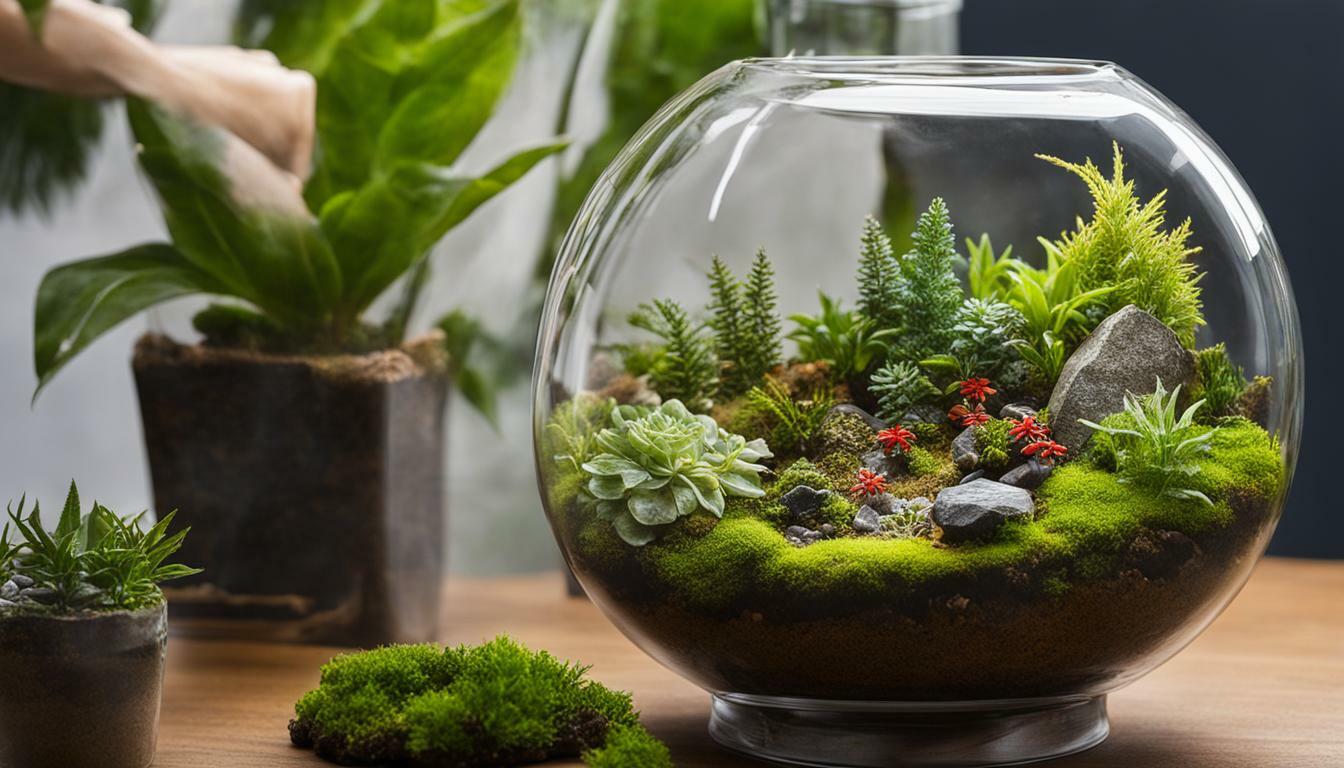Terrariums are a popular choice for indoor gardening, and with proper care and maintenance, they can become a beautiful addition to any space. These miniature ecosystems not only bring nature indoors, but they also offer a sense of tranquility and relaxation. However, to ensure the longevity and thriving growth of your terrarium, it is essential to understand the necessary care and upkeep required.
- Position your terrarium based on the light requirements of the plants, with closed terrariums needing indirect light and open terrariums requiring full or partial sun.
- Watering frequency varies for open and closed terrariums, with succulents and cacti needing weekly watering in open terrariums.
- Regular pruning is necessary to keep your terrarium plants neat and remove any dead leaves or stems.
- If plants in a closed terrarium become brown and moist, they may be receiving too much light and should be moved to a shadier spot.
- Regular cleaning of the terrarium glass is important to allow sufficient light to reach the plants.
Understanding Terrarium Types and Lighting Requirements
Terrariums come in various types, including closed and open terrariums, each with its own lighting requirements to ensure the health and growth of the plants within. Closed terrariums, also known as self-contained ecosystems, create a humid environment that is ideal for plants that thrive in moist conditions. These terrariums should be placed in areas with indirect light to prevent overheating and excessive moisture build-up. On the other hand, open terrariums require more light exposure, either full or partial sun, to support the growth of plants that prefer drier soil and good airflow.
When positioning your terrarium, it is crucial to consider the specific light needs of the plants you choose. Some plants, such as succulents and cacti, require bright but indirect light in open terrariums to prevent burning or drying out. Others, like ferns and mosses, thrive in the lower light levels found in closed terrariums. By understanding the lighting requirements of your terrarium type and the plants within, you can create an environment that supports their well-being.
Tables can be a useful way to consolidate information. Here is an example of a table that outlines the lighting requirements for different terrarium types:
| Terrarium Type | Lighting Requirements |
|---|---|
| Closed Terrariums | Indirect, low to medium light |
| Open Terrariums | Full or partial sun |
Understanding the lighting needs of your terrarium and its plant inhabitants is essential for their overall health and success. By providing the appropriate amount of light, you can ensure that your terrarium thrives as a beautiful and captivating miniature ecosystem.
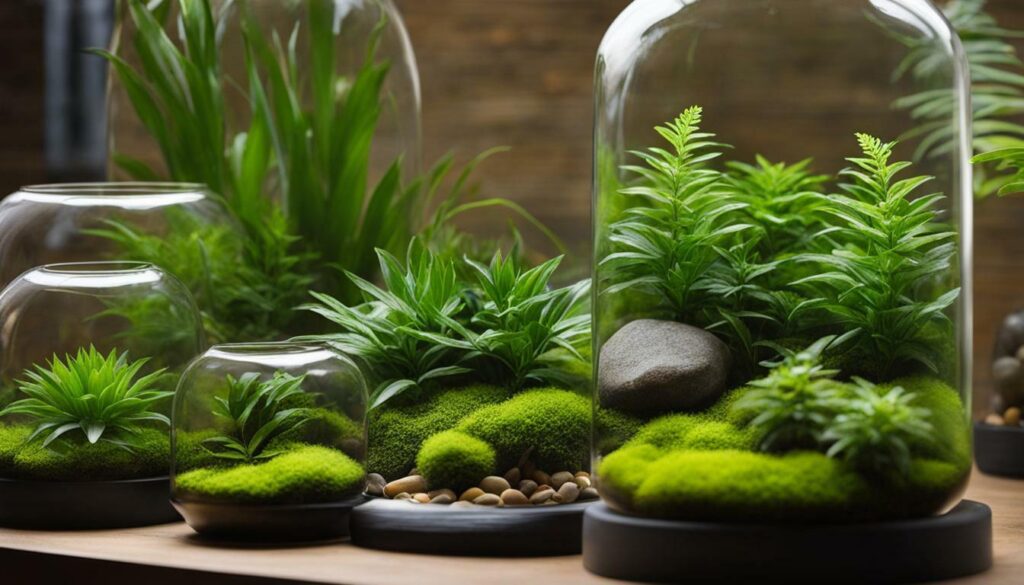
Proper lighting is crucial for maintaining a healthy terrarium. Here are some lighting tips to keep in mind:
- When placing your terrarium, consider the amount of natural light it will receive throughout the day. Avoid direct sunlight, as it can cause overheating and damage the plants.
- If your terrarium is in a location with insufficient natural light, you can supplement it with artificial lighting. LED grow lights are a popular choice for providing the necessary light spectrum for plant growth.
- Monitor your terrarium regularly to ensure that the plants are receiving the right amount of light. Signs of insufficient light include pale or leggy growth, while signs of excessive light exposure include scorched leaves or stunted growth.
By maintaining appropriate lighting conditions, your terrarium will flourish and provide you with a beautiful and serene miniaturized garden.
Watering and Moisture Balance for Terrariums
Proper watering is essential for the well-being of terrarium plants, and understanding the differences in watering frequency and methods between open and closed terrariums is crucial. Open terrariums, which typically house succulents and cacti, require less frequent watering compared to closed terrariums. Succulents and cacti are drought-tolerant plants that store water in their leaves and stems, allowing them to withstand longer periods without moisture. In an open terrarium, watering once a week is generally sufficient, but always monitor the soil conditions and adjust accordingly. It is important to water these terrariums thoroughly, allowing excess water to drain out of the bottom.
On the other hand, closed terrariums create a self-sustaining environment where moisture is recycled. The closed glass container traps moisture, creating a humid environment that mimics the natural habitat of tropical plants. Typically, closed terrariums do not require frequent watering as the moisture inside is continually recycled. However, if you notice excessive condensation or a soggy appearance of the soil, it may indicate overwatering. In such cases, it is recommended to remove the lid temporarily to allow excess moisture to dissipate. Monitoring the moisture levels and observing the appearance of the plants is crucial to maintain the proper balance of humidity.
To help you keep track of your watering schedule, refer to the table below for a quick overview:
| Terrarium Type | Watering Frequency |
|---|---|
| Open Terrarium | Once a week |
| Closed Terrarium | Infrequent watering, monitor moisture levels |
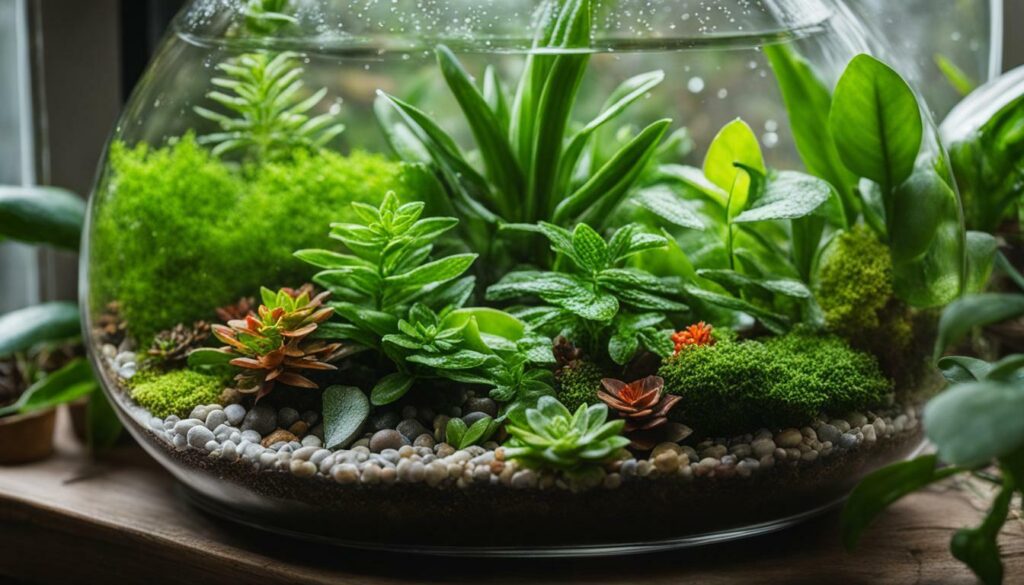
Remember that each terrarium and its plant composition is unique, and factors such as temperature, humidity, and plant species will influence watering needs. It’s important to observe and assess the condition of your terrarium regularly, adjusting your watering routine accordingly. By maintaining the appropriate moisture balance, you can create a thriving and beautiful mini ecosystem within your terrarium.
Pruning and Plant Maintenance in Terrariums
Regular pruning is necessary to keep terrarium plants healthy, neat, and free from any decaying parts that can negatively impact the overall appearance and well-being of the mini ecosystem. As plants grow, it is important to remove any dead leaves or stems to promote new growth and prevent the spread of disease. Pruning also helps to maintain the desired size and shape of the plants within the terrarium.
To effectively prune terrarium plants, it is important to use clean and sterilized pruning tools to prevent the spread of any potential pathogens. Before beginning the pruning process, inspect the plants carefully for any signs of dead or dying leaves, stems, or flowers. Trim these parts using sharp, clean scissors or pruning shears, making sure to cut just above a healthy leaf or bud.
While pruning, it is also a good time to check for any overcrowding within the terrarium. If plants are competing for space or blocking each other’s access to light, it may be necessary to remove or transplant some of them. This will ensure that all the plants have sufficient space to grow and thrive.
Pruning Tips:
- Trim dead or decaying parts of the plant.
- Use clean and sterilized pruning tools.
- Remove overcrowded plants to promote healthy growth.
- Regularly inspect and prune to maintain the appearance of the terrarium.
Remember, proper pruning and plant maintenance are essential for the long-term health and vibrancy of your terrarium. By keeping your plants neat and free from dead or decaying parts, you can create a beautiful and thriving mini ecosystem that brings joy and relaxation to your space.
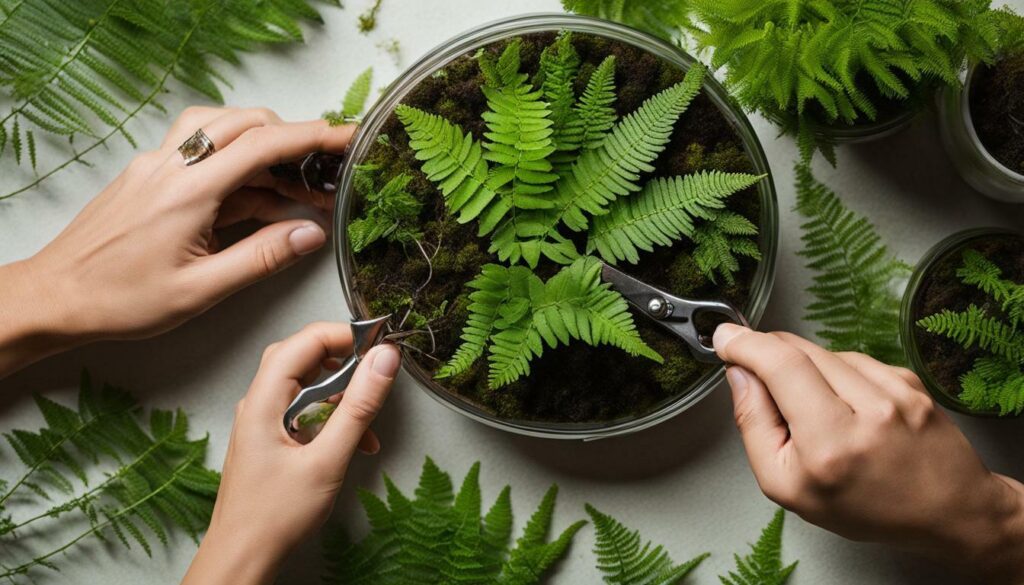
| Pruning and Plant Maintenance in Terrariums | Benefits |
|---|---|
| Promotes new growth | Keeps the terrarium neat and attractive |
| Prevents disease spread | Ensures the overall health of the mini ecosystem |
| Allows for proper light distribution | Prevents overcrowding and competition |
Proper Placement and Lighting for Terrariums
The placement of your terrarium is crucial for its success, as improper lighting conditions can lead to plant stress and detrimentally affect the health and longevity of your terrarium. When choosing the perfect spot for your terrarium, it is essential to consider the specific light requirements of the plants it contains.
For closed terrariums, which have a sealed environment, indirect light is ideal. Placing them near a north-facing window or a few feet away from an east- or west-facing window allows for gentle, filtered light. Avoid direct sunlight, as it can cause excessive heat and create a greenhouse effect, resulting in plant damage.
On the other hand, open terrariums, which have an uncovered or partially covered top, require more light. Position them near a south-facing window or in a spot that receives full or partial sun. Remember to monitor the temperature to prevent overheating, especially during hot summer months.
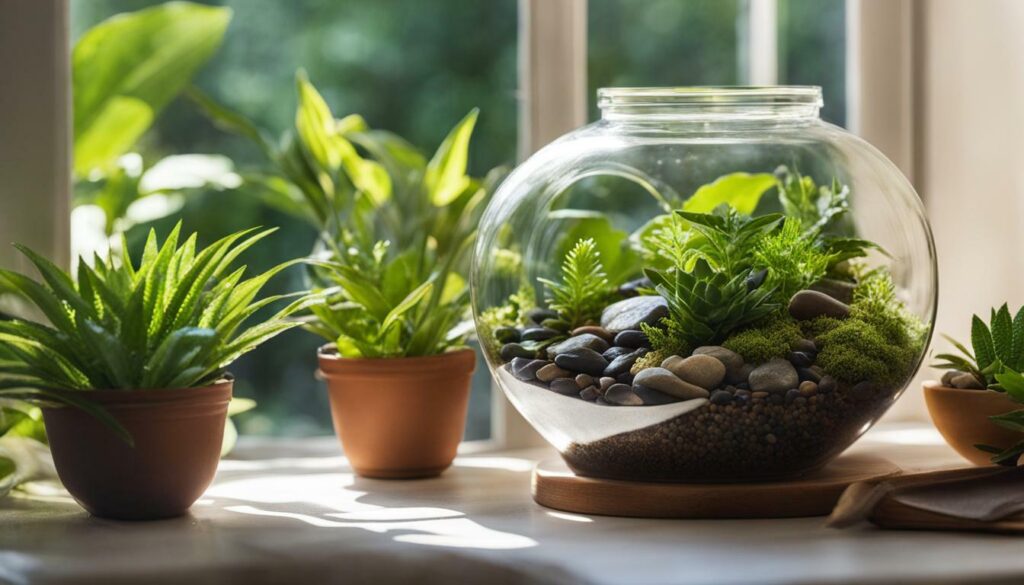
By providing the right lighting conditions, you can ensure your terrarium thrives and creates a beautiful, harmonious display of nature within your home or office.
Key Tips for Proper Placement and Lighting:
- Choose a north-facing window or position your closed terrarium a few feet away from an east- or west-facing window.
- Avoid placing closed terrariums in direct sunlight to prevent excessive heat.
- For open terrariums, place them near a south-facing window or in a spot with full or partial sun exposure.
- Monitor the temperature to prevent overheating, especially during the summer months.
Remember, each terrarium is unique, and it is crucial to observe the plants’ response to their lighting conditions regularly. Adjust the placement as needed to maintain optimal health and growth.
Cleaning and Sanitizing Terrarium Glass
To maintain a vibrant and visually appealing terrarium, regular cleaning and sanitizing of the glass container is necessary to remove dust, water spots, and other debris that can hinder the plants’ growth. The process is simple and ensures that the terrarium remains a healthy environment for your plants to thrive.
Start by removing any plants or decorative elements from the terrarium. Gently wipe the glass walls with a soft cloth or sponge dampened with a mixture of mild dish soap and warm water. Avoid using harsh chemicals or abrasive materials that can scratch the glass. Pay attention to all sides of the glass, including the corners and crevices, to ensure a thorough cleaning.
After cleaning, rinse the glass container with clean water to remove any soap residue. Use a soft cloth or paper towel to dry the glass, making sure to remove all moisture. This step is important to prevent water spots from forming on the glass surface.
Once the glass is clean and dry, you can return the plants and decorations to the terrarium. Take this opportunity to rearrange the elements if desired, creating an aesthetically pleasing display. Regular cleaning and sanitizing of the terrarium glass will not only enhance the visual appeal of your terrarium but also promote the health and well-being of the plants within.
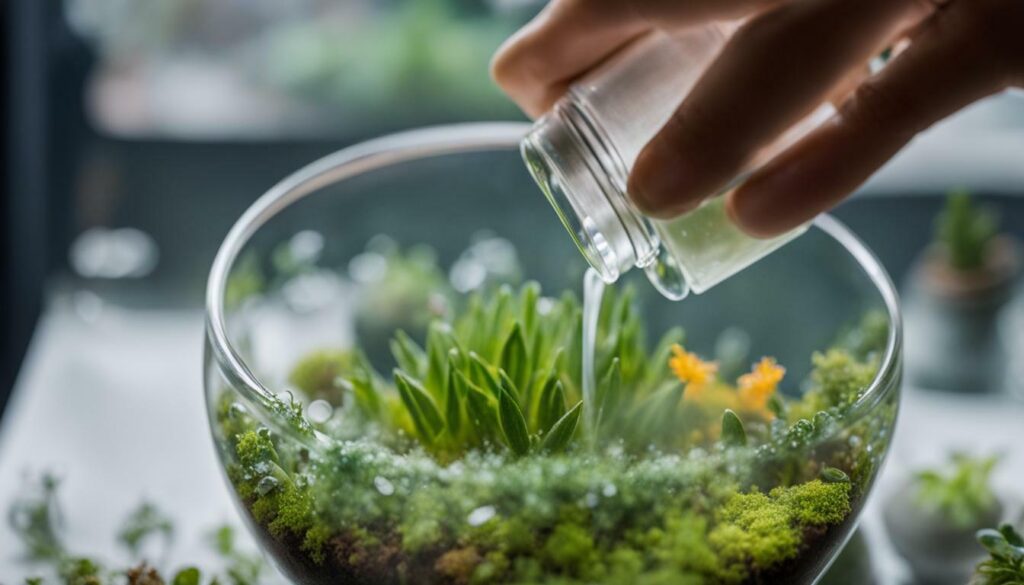
| Materials Needed | Instructions |
|---|---|
| Soft cloth or sponge | 1. Remove plants and decorations from the terrarium. |
| Mild dish soap | 2. Dampen the cloth or sponge with a mixture of mild dish soap and warm water. |
| Warm water | 3. Gently wipe the glass walls, paying attention to all sides and corners. |
| Paper towel | 4. Rinse the glass container with clean water and dry thoroughly to prevent water spots. |
| Plants and decorations | 5. Return the plants and decorations to the terrarium, rearranging as desired. |
Fertilization and Plant Selection for Terrariums
While terrarium plants generally do not require fertilization, understanding the importance of selecting suitable plants based on their light requirements is crucial for long-term success. The lack of fertilization is due to the self-contained nature of terrariums, where the plants obtain nutrients from the soil and decomposing matter within the enclosed environment.
When choosing plants for your terrarium, it is essential to consider their light requirements. Different plants have varying needs for light intensity and duration. Some plants thrive in low light conditions, while others require bright, indirect light. By selecting plants that match the light requirements of your terrarium, you can ensure optimal growth and avoid issues such as leggy or weak plants.
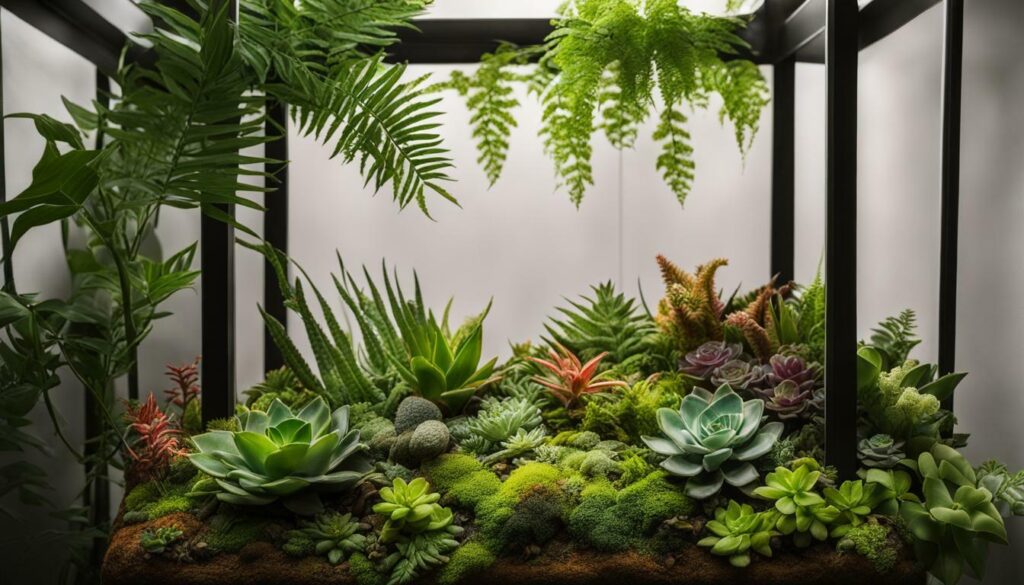
To help you make informed decisions, here is a table outlining the light requirements of common terrarium plants:
| Plant | Light Requirements |
|---|---|
| Sansevieria (Snake Plant) | Low to medium light |
| Pilea peperomioides (Chinese Money Plant) | Medium to bright, indirect light |
| Ferns (e.g., Maidenhair Fern, Boston Fern) | Medium to indirect light |
| Haworthia (Zebra Plant) | Bright, indirect light |
By selecting plants that suit the light conditions of your terrarium, you can create a harmonious and thriving mini ecosystem. Remember to regularly monitor and adjust the placement of your terrarium to ensure the plants receive the optimal amount of light for their growth and well-being.
Proper Airflow for Succulents in Terrariums
Succulents are a popular choice for terrariums, but their unique needs for proper airflow and moisture control require careful consideration when selecting the type of terrarium to house them. Succulents thrive in dry conditions and can be prone to root rot if exposed to excessive moisture. Uncovered terrariums, also known as open terrariums, are the ideal choice for succulents as they provide better airflow and allow excess moisture to evaporate.
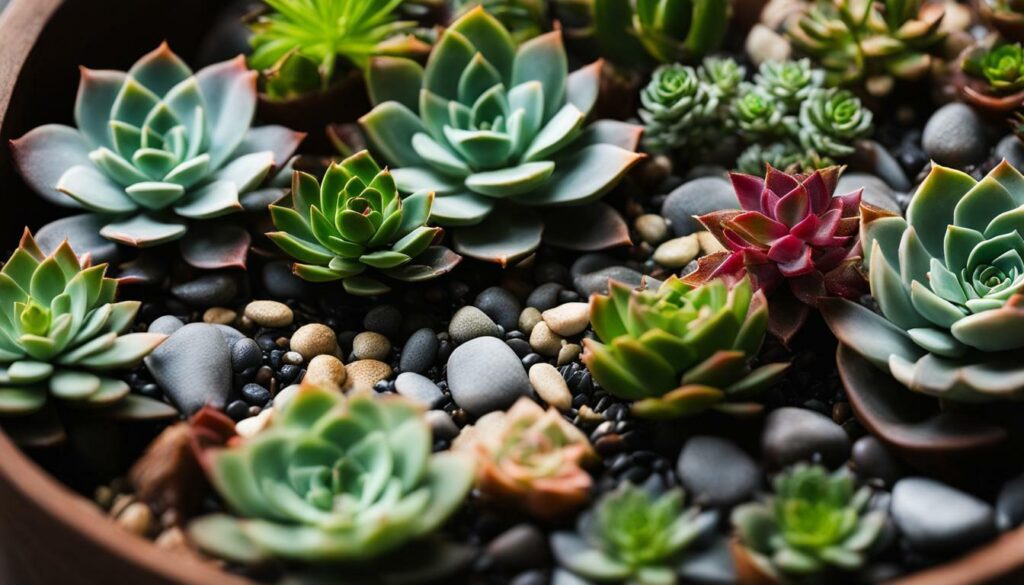
Succulents, such as cacti and jade plants, have adapted to survive in arid environments by storing water in their leaves and stems. In closed terrariums, where the moisture level is higher and the airflow is limited, succulents may struggle to thrive and could experience issues like root rot. To ensure the health and longevity of your succulents, opt for uncovered terrariums that promote proper ventilation and prevent excess moisture buildup.
To create a suitable environment for succulents, use a well-draining potting mix specifically formulated for cacti and succulents. This type of soil allows excess water to flow through, reducing the risk of waterlogged roots. Placing a layer of small stones or pebbles at the bottom of the terrarium can further aid in drainage. Additionally, make sure to water succulents sparingly, allowing the soil to dry out completely between waterings.
Key Tips for Succulent Terrariums:
- Choose an uncovered terrarium to provide proper airflow and prevent moisture buildup.
- Use a well-draining potting mix specifically formulated for succulents and cacti.
- Add a layer of small stones or pebbles at the bottom of the terrarium for additional drainage.
- Water succulents sparingly, allowing the soil to dry out completely between waterings.
By following these guidelines, you can create a favorable environment for your succulents and ensure their long-term health and beauty in your terrarium.
| Succulent Terrarium Care Summary |
|---|
| Choose an uncovered terrarium for proper airflow |
| Use well-draining potting mix for succulents |
| Layer small stones at the bottom for drainage |
| Water sparingly, allowing soil to dry out between waterings |
Creating the Right Environment for Tropical Plants
Tropical plants thrive in terrariums that offer a humid and moist environment, making them an excellent choice for those looking to recreate a lush tropical atmosphere indoors. To ensure the optimal conditions for these plants, it’s important to consider a few key factors:
- Moisture: Tropical plants require high levels of humidity to thrive. It’s essential to provide regular misting or a water source within the terrarium to maintain the desired moisture levels. This creates a humid microclimate that mimics their natural habitat and promotes healthy growth.
- Temperature: These plants prefer warmer temperatures, typically ranging between 70°F and 80°F (21°C – 27°C). It’s important to keep the terrarium in a location where the temperature remains consistently within this range, away from drafts or fluctuations.
- Lighting: Tropical plants thrive in bright, indirect light. Placing the terrarium near a window with filtered light or using artificial grow lights with the appropriate spectrum can provide the necessary light for optimal growth.
Creating the right environment for tropical plants also involves careful plant selection. Some popular choices for terrariums include ferns, orchids, bromeliads, and mosses. These plants not only add beauty to the terrarium but also thrive in the humid conditions.
Quote: “Tropical terrariums bring a touch of paradise into your home. The lush green foliage, vibrant flowers, and delicate fronds create a tranquil and refreshing atmosphere, perfect for relaxation and rejuvenation.”
To showcase the beauty of tropical plants in a terrarium, it’s important to choose an appropriate container and substrate. Glass terrariums with a tight-fitting lid are ideal for creating the desired humid environment. Using a mix of well-draining potting soil and peat moss provides the necessary moisture retention while allowing excess water to drain.
Quote: “The key to success with tropical terrariums is to strike the perfect balance of moisture, temperature, and lighting. By replicating their natural habitat, you can create a thriving miniature rainforest right in your home.”
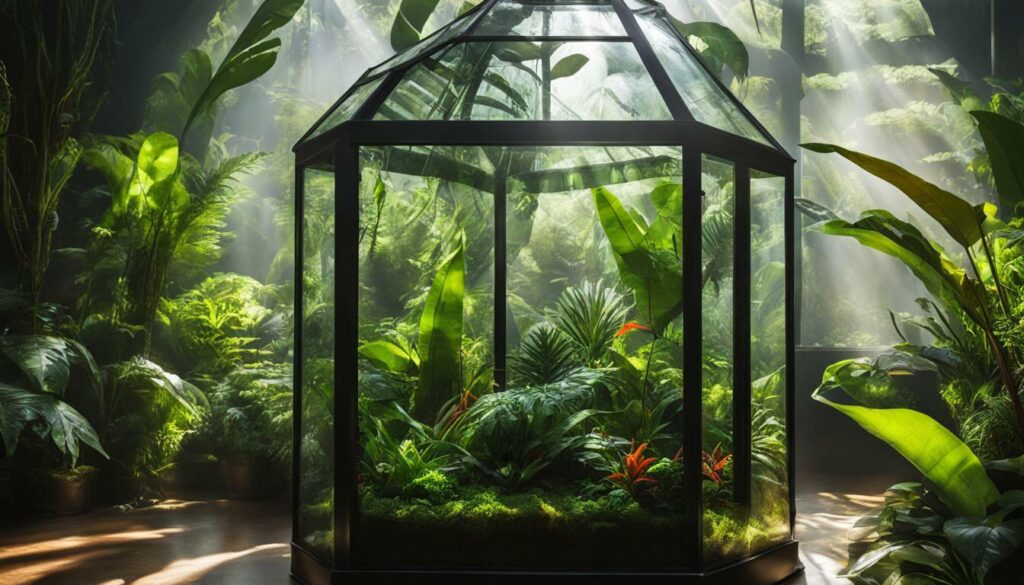
In summary, tropical plants thrive in terrariums that provide a humid and moist environment. By maintaining the right moisture levels, temperature, and lighting, you can recreate a lush tropical atmosphere indoors. With careful plant selection and the use of suitable containers and substrate, you can create a stunning and vibrant tropical terrarium that brings a touch of paradise into your home.
Proper Preparation and Placement for Terrariums
To set your terrarium up for success, proper preparation involving clean glass and appropriate potting mix, along with careful consideration of its placement away from direct sunlight, is essential. Terrariums are unique miniature ecosystems that require specific conditions to thrive. By following these steps, you can ensure that your terrarium provides a healthy environment for your plants and creates a beautiful centerpiece for your home.
First and foremost, clean the terrarium glass thoroughly before adding any plants. Use a gentle glass cleaner and a soft cloth to remove any dirt or smudges. Clean glass allows sufficient light to reach the plants, promoting their growth and maintaining a vibrant terrarium. Once the glass is clean, it’s time to prepare the potting mix. Make sure to use a sterile potting mix specifically designed for terrariums. This ensures that the soil is free from harmful bacteria or pests that could harm your plants.
When it comes to placement, finding the right spot for your terrarium is crucial. Avoid placing it in direct sunlight, as this can cause the temperature inside the terrarium to rise too high, damaging the delicate plants. Instead, choose a location that receives indirect or filtered sunlight. Consider placing your terrarium near a window that faces east or west, where it can benefit from the gentle morning or late afternoon sun. If you notice that the plants in your closed terrarium become brown and moist, it could be a sign that they are receiving too much light. In this case, simply move the terrarium to a shadier spot to restore its moisture balance.
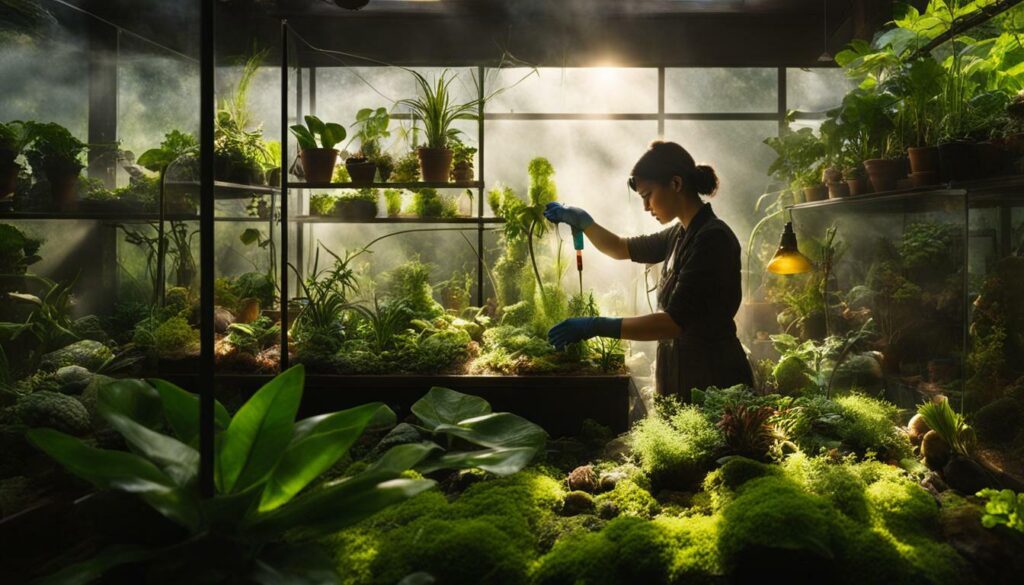
With proper preparation and thoughtful placement, your terrarium will flourish and bring a touch of nature to your indoor space. Remember to clean the glass regularly, use sterile potting mix, and find an ideal location away from direct sunlight. By following these steps and providing proper care, you can create a captivating terrarium that will be a source of joy and tranquility in your home.
What are the Essential Tips for Terrarium Care and Upkeep?
When it comes to terrarium care, a comprehensive terrarium care guide is essential. To upkeep your terrarium, proper watering is crucial. Additionally, ensure the terrarium receives adequate sunlight and keep an eye on any signs of pests or disease. Regular cleaning and pruning will also maintain a healthy terrarium.
Conclusion
Taking care of your terrarium and keeping up with its maintenance needs is the key to a beautiful and thriving ecosystem that brings joy and tranquility to any space. Terrariums are low-maintenance and create calming landscapes, but they still require regular attention to ensure the health and vitality of the plants within.
When positioning your terrarium, it’s crucial to consider the light requirements of each plant. Closed terrariums prefer indirect light, while open terrariums require full or partial sun. By providing the right amount of light, you create an ideal environment for your terrarium plants to flourish.
Watering frequency also plays a significant role in terrarium care. Open terrariums typically require more frequent watering, while closed terrariums often maintain their own moisture balance. Succulents and cacti in open terrariums should be watered weekly to prevent dehydration.
Pruning is necessary to keep your terrarium plants neat and healthy. Removing dead leaves or stems not only improves the aesthetic appeal but also promotes better plant growth. Additionally, if you notice plants becoming brown and moist in a closed terrarium, it may be an indication of receiving too much light. In such cases, consider moving them to a shadier spot.
To maintain a clear view of your terrarium’s beauty, regular cleaning of the glass is essential. Clean glass allows sufficient light to reach the plants and promotes a healthier environment. Before planting, ensure the terrarium glass is cleaned and sterilized, and use sterile potting mix for optimal growth.
Fertilization is generally not required for terrarium plants, as they receive sufficient nutrients from the soil. However, when selecting plants for your terrarium, consider their suitability for the specific terrarium type and light requirements. This ensures that you have a cohesive ecosystem where all plants thrive together.
For succulents, it’s important to create an environment with proper airflow. Plant them in uncovered terrariums to allow for adequate ventilation and prevent humidity-related issues. On the other hand, plants that thrive in tropical environments prefer moist conditions, so select a terrarium type that can provide the desired level of humidity.
Lastly, when choosing a spot for your terrarium, ensure it’s away from direct sunlight. Excessive heat can harm the plants, so find a location where they can enjoy indirect light without being exposed to high temperatures. By following these maintenance tips, you can enjoy the beauty and tranquility of your terrarium for years to come.
FAQ
What are the light requirements for terrariums?
Closed terrariums need indirect light, while open terrariums require full or partial sun.
How often should I water my terrarium?
Open terrariums typically require more frequent watering, while closed terrariums often maintain their own moisture balance. Succulents and cacti in open terrariums should be watered weekly.
Do I need to prune my plants in a terrarium?
Yes, pruning is necessary to keep plants neat and remove dead leaves or stems.
What should I do if my plants become brown and moist in a closed terrarium?
If plants become brown and moist, they may be receiving too much light. It’s best to move them to a shadier spot.
How often should I clean the glass of my terrarium?
Regular cleaning of the terrarium glass is important for allowing light to reach the plants. It is recommended to clean the glass before use and regularly thereafter.
Do terrarium plants need to be fertilized?
Terrarium plants generally do not need to be fertilized. However, proper plant selection based on light requirements is important for their overall health.
Can I plant succulents in a covered terrarium?
Succulents should be planted in uncovered terrariums to allow for proper airflow and prevent humidity-related issues.
What type of terrarium is best for tropical plants?
Terrariums requiring moist conditions are preferable for plants that thrive in tropical environments.
How should I prepare and place my terrarium?
Before use, clean the terrarium glass and use sterile potting mix. Place the terrarium away from direct sunlight to avoid high temperatures that can harm the plants.
Do I need to replace plants in my terrarium?
Pruning and replacing plants may be necessary for maintaining the overall health and appearance of the terrarium.

